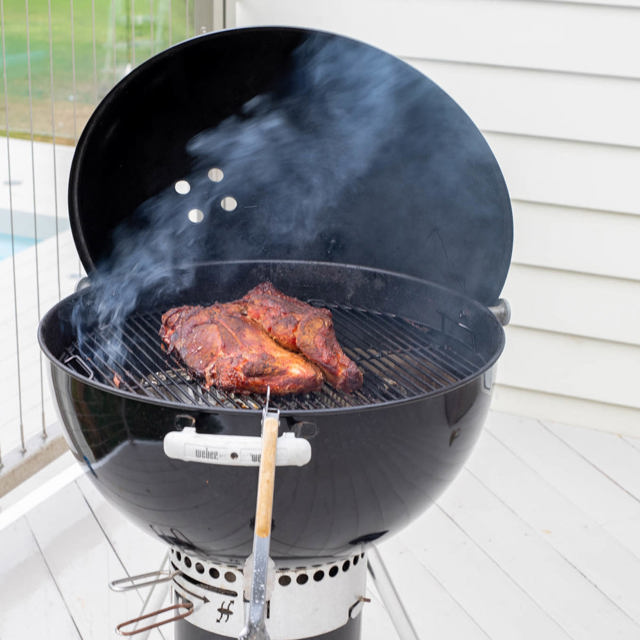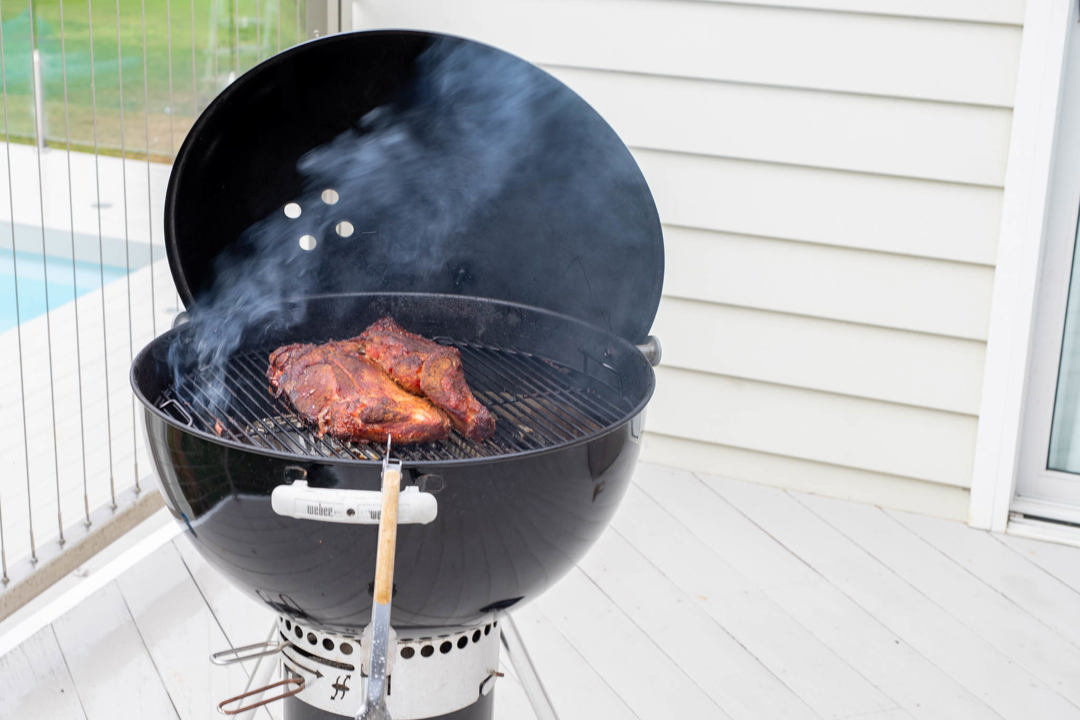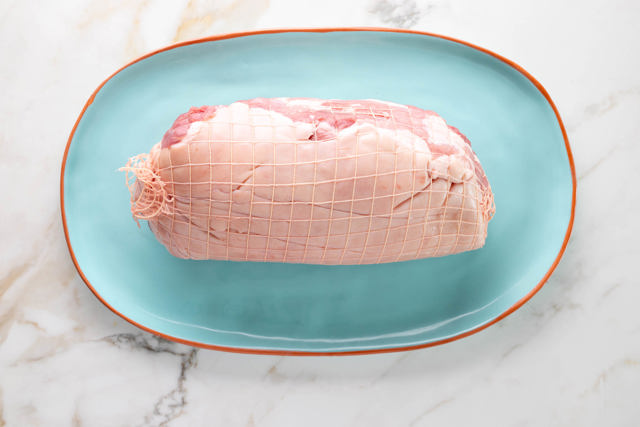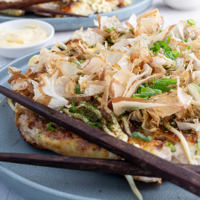I still remember the first time I had pulled pork - it was like a revelation to me! The sweet pork meat, along with an awesome homemade BBQ sauce was incredible in a soft brioche bun. Pulled pork is one of those things that when done right transcends the simplicity of its ingredients and is supremely comforting; fantastic as part of a BBQ plate, or as a burger, or even just as a sandwich filling.
This is a recipe for an approachable smoked pulled pork recipe. My instructions have been written for a charcoal grill like a Weber - because these are so common - but you should be able to adapt this recipe to work with a pellet smoker, offset smoker, etc.
What is Smoked Pulled Pork?
At its core, Smoked Pulled Pork is pork shoulder which is smoked and slow cooked. The internal temperature is raised to the point that the collagen breaks down to gelatine, which transforms the usually tough pork shoulder into buttery soft meat which can be pulled into shreds.
What you need to make Smoked Pulled Pork
- Something to smoke the pork in - I've written this recipe using a charcoal grill, like a Weber, because of their enduring popularity and number of clones that are available. You can easily adapt this recipe for an offset smoker, charcoal smoker, etc.
- Wood chunks - your favourite smoking wood. Read more below about which wood to use. Don't use wood chips because these burn too quickly.
- Charcoal - use charcoal or briquettes as the heat source while smoking the meat.
- Thermometer - to make sure the pork is perfectly cooked, we need a thermometer to monitor the internal temperature while it is smoking and in the oven.
Smoked Pulled Pork ingredients
- Pork - you can't have pulled pork without pork! And you can't have pulled pork without using a shoulder of pork, it just doesn't work with other cuts like the leg. Read about which cuts of pork to use.
- BBQ sauce - you can make your own, or use your favourite sauce to stir through the pork. I suggest you use a smoky sauce! I have a recipe for a great BBQ sauce which you can see use.
- Spice rub - the spice blend adds amazing flavour to the pork and is made from a mixture of spices like sugar, salt, pepper, garlic, onion powder and paprika - check the recipe for details.
How to make Smoked Pulled Pork
Soak your wood chunks for at least an hour before you want to start. This prevents the wood from burning too quickly and helps you get more smoke from the wood.
Light your fire over a low heat. You want the BBQ to be around 100-120C (212-248F). Using a chimney starter, you need about half a chimney of charcoal.
While the coals are igniting, start preparing the pork. If the pork is boneless, remove the netting.
If the pork has the skin attached, you need to remove it along with most of the fat between the muscle and the skin.
Make the rub by putting all the rub ingredients together (1) and combining (2). Press the rub into all sides of the pork (3).
Put the pork on the grill and smoke with a single chunk of wood on the coals. Monitor both the grill and meat temperature, adjust the air vents to keep the temperature in the range of 100-120C (212-248F). Add more wood chunks as they burn out, and you might need to add more charcoal or briquettes as they burn down.
Smoke for about 4 hours until the internal temperature is approx. 70C (158F). Remove the pork from the grill and wrap well in foil. Place in an oven set to 120C (248F) for approx. 3 hours or until the internal temperature reads 93-96C (200-205F) on a thermometer.
Using meat claws, two forks, or gloved hands, pull the meat into shreds. Discard any bones, chunks of fat, gristle, etc.
What to serve with pulled pork
Pulled pork is awesome in burgers, as part of a barbecue plate, or in sandwiches. If you're doing burgers, serve with a simple coleslaw. If you're doing a more elaborate barbecue plate, sides such as corn bread, mac and cheese, American style baked beans, corn on the cob, biscuits and gravy, coleslaw, hush puppies and green beans work well.
If you want to try a fancier coleslaw, try my favourite coleslaw recipe!
The pulled pork benefits greatly by stirring through a quality BBQ sauce. Try my best BBQ sauce with this pork, you won't be disappointed!
How do I remove the skin, and what can I do with it?
Ideally, get your butcher to remove the skin for you. If you buy the meat from the supermarket it will probably have the skin attached; you can easily remove it but you need to be careful not to remove too much of the fat while you're cutting it off. I have instructions below on removing the skin.
If you're not comfortable cutting the skin off, you can cook it skin on, but you won't get as much flavour penetration from the spice mix. The skin won't crackle with this recipe because it will get too much moisture in the slow cooker.
If you do remove the skin, you can absolutely crackle it up - check my oven crackling recipe.
To remove the skin:
Take your time. Start by using a sharp knife and placing the knife between the top of the meat and the skin. Make a cut about an inch of the way in and pick the loose skin up with your other hand. Slowly slide the knife to cut through, taking the slack up in your other hand while you continue to cut through.
When the skin is removed, trim off excess fat. You want to keep some fat to help baste the meat during cooking. It's hard to give accurate instructions here because fat content of pork can vary a lot, but you essentially want to retain a thin layer of fat on the top of the pork.
Which cut of pork should I use?
This will only work with pork shoulder. Ideally, use what Americans call the butt, which is cut from the top part of the shoulder. Your butcher may or may not know this cut, I've had mixed luck in getting it here in Australia; I've learned to be prepared and have an image of the cut saved on my phone and when they see it they know exactly what I'm after.
If you're buying from the supermarket, at least in Australia you won't have any control over what part of the shoulder you get. You may pay a little bit more for it, but you'll get better quality meat and the right cut if you go and support your local butcher. With that said though, this recipe is still great regardless of which part of the shoulder you use.
Don't be tempted to use pork leg - it doesn't work!
Bone in or out?
Some people believe that keeping the meat bone in gives more flavour, but I don't think it's noticeable. There are benefits to having the bone in though - you can use that smoky bone to make an awesome broth or stew and hit it with some great porky flavour.
How do I know it's ready, and how do I pull/shred the meat?
You know the meat is ready when it easily breaks apart with a fork. The flesh should feel very soft, and it easily pulled apart into strands. You're looking for an internal temperature of around 93-96C - don't cook it above this point.
To pull the meat, you can use two forks, or you can buy something like meat claws which helps get the job done more easily. When you shred the meat, remove any bone, cartilage or anything else that looks gnarly that may be present.
Can I freeze pulled pork?
Absolutely, it freezes well!
What to do with left over pulled pork?
Reheat it in a frying pan over a low heat, or in the microwave, or even the oven, and eat however you want - on its own, in a sandwich, in a burger... however you like it 😊
What type of wood should I use to smoke?
When it comes to smoking pork, the choice of wood can significantly impact the flavour of the meat. Different types of wood will impart different flavours and smells to the pork.
My three recommendations would be:
- Hickory - this is very commonly used with smoking pork. It has a strong and robust flavour that adds a rich, smoky taste to the meat.
- Apple - Apple wood provides a mild and sweet taste to the smoking pork. It imparts a pleasant, subtle sweetness.
- Cherry - Cherry wood, like apple, imparts a mild, sweet and fruity flavour to the pork. It also gives a little tartness and can add a nice red colour to the outside of the pork.
Most other woods such as maple, pecan, or oak can be used, but avoid stronger woods such as mesquite. An overly strong wood can quickly overpower smoked meats, particularly on low-and-slow cooks.
How do I maintain temperature on a charcoal grill?
For low-and-slow style BBQ cooking it's important that your BBQ has an accurate thermometer fitted, or you buy a probe thermometer to monitor the internal temperature of the BBQ. It's also a good idea to get either an instant read thermometer, or if using a probe to monitor the cooking temperature, to get a dual-probe setup so that you can also monitor the internal meat temperature.
Most grills have two vents - one at the base, one on the lid. The base vent is usually located under the charcoal and controls the inflow of oxygen which determines the intensity of the fire. The top vent, on the other hand, controls the outflow of heat and smoke.
The two vents are used in tandem to regulate how intensely the charcoal is burning and thus how hot the fire is.
When you adjust the vents, make small adjustments and monitor the effect on your thermometer. Avoid making large adjustments to the vents to prevent large spikes or drops in temperature.
This does take experience but using your thermometer to monitor the cooking temperature you'll start to learn how your grill behaves when you make adjustments. Frequently check the temperature because you don't want to burn your food, or put the fire out.
Finally, you should never completely close the top vent. There needs to be some air flow and you will choke the fire if you shut the vent off completely. Closing the top vent can also cause you to over smoke your food.
Why do we wrap the pork in foil?
Wrapping smoked meats in foil is known as the "Texas Crutch". Wrapping in foil helps to keep the meat moist during long cooks and push through the stall, which is when the internal temperature of the meat plateaus and can remain steady for an extended period due to evaporative cooling.
Keeping the meat moist makes sure that you don't end up with dry meat from the extended cooking process.
When you wrap your meat, you can experiment with adding different liquid (i.e. apple juice), herbs or sauces which will cook with the meat and allow it to take on a different flavour profile.
Using a steam oven to finish pulled pork
If you have a steam oven, you can finish cooking the pork in it after it's been smoked. There's no need to wrap it in foil.
Finish the pork in the steam oven at 100C with 100% humidity.

Smoked Pulled Pork
| Prep | Cook | Total |
|---|---|---|
| 15 mins | 480 mins | 495 mins |
- 3-4 wood chunks of choice - hickory or apple recommended see note 1
- 1x 2.5kg boneless shoulder of pork, skin removed see note 2
- 1 tbsp (17g) cooking salt see note 3
- BBQ Sauce, to serve, optional
- 1/3 cup packed brown sugar (75g)
- 2 tbsp (14g) cracked pepper
- 2 tbsp (14g) paprika
- 2 tbsp (8g) garlic powder
- 1 tbsp (6g) onion powder
- Soak wood - soak 3-4 wood chunks of choice in water. You want to give this at least an hour so that the wood doesn't burn too quickly and smokes well.
- Light charcoal - If you're using a charcoal smoker, light it. I use half a chimney of charcoal which at the temperature I smoke (100-120C, 212-248F) lasts me long enough to get the smoke done.
- Remove any excess fat from the top of the pork. Pork shoulder is full of intramuscular fat and the bark won't develop properly on top of the fat cap.
- Apply the salt over all sides of the meat. This is optional, but I like to apply the salt before the rub, because it lets me eyeball the seasoning. If you prefer you can mix the salt with the rest of the rub ingredients. You're looking for a good coverage of salt - you might need to add a bit more - but take care not to over salt the meat. You can always adjust seasoning when you serve.
- Make rub by adding all ingredients for the rub together and mixing well to combine. Apply to all sides of the pork, and then roll the pork around and press in any of the rub that might have fallen off or not properly adhered.
- Start smoking pork - when your coals are lit, disperse them evenly on each side of the smoker for indirect cooking. Place the pork in the middle of the BBQ. Grab a chunk of your soaked smoking wood and shake off excess water and then place on top of the coals.
- Monitor the grill temperature and adjust the vents to keep the grill between 100-120C (212-248F). Monitor the smoke output and add additional chunks as needed - alternating which side of the grill you place the chunk on.
- Cook the pork for about 3.5-4 hours at 100-120C (212-248F) until a thermometer reads around 71C (160F) internal temperature.
- Remove the pork from the BBQ and preheat oven to 120C. Wrap in several layers of aluminium foil, and place the wrapped pork on a tray in the oven. Cook for a further 3-4 hours, until the internal temperature of the pork is in the range of 93-96C (200-205F) and can be easily shredded with a fork.
- Remove pork from the oven. Pour the liquid in the foil into a jug and discard foil. Place on a chopping board or serving bowl and use your hands, meat claws or two forks to shred the meat, removing any excess fat, gristle, arteries, etc. Place the meat into an appropriate serving container and pour over a little of the reserved juice to moisten the meat. Adjust seasoning and serve, stirring through BBQ sauce to taste, if you'd like.
- Wood - Use chunks, not chips. Hickory, Apple and Cherry woods all pair very well with pork. Don't use strong woods like mesquite and don't use wood chips because they burn too quickly.
- Pork - Ideally use the butt cut from the top of the shoulder. It yields the best pulled pork, but any cut from the shoulder will give you a great result. In Australia, you won't find this in supermarkets so ask your butcher. Select a piece around 2.5kg, but a few hundred grams either way won't make much of a difference. The skin should be removed, see instructions in the post.
- Salt - Make sure you use a coarse cooking salt, not a fine table salt, because you might over salt the meat. You can apply the salt directly to the meat or mix it as part of the rub.
- BBQ sauce - I've linked my BBQ sauce recipe which pairs excellently with this smoked pulled pork. You can also use your favourite store bought sauce if you prefer, or leave it out.
- Serving suggestion - what I've listed is BBQ favourites that pair very well with smoked pulled pork.
- Steam oven - if you have a full steam oven, you can finish cooking the pork in the steam oven rather than a conventional oven. Cook at 100C (212F) with 100% humidity - there's no need to wrap it in foil.































